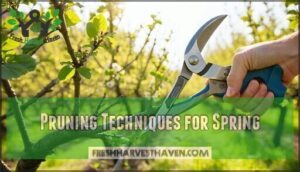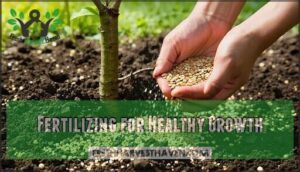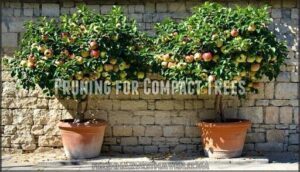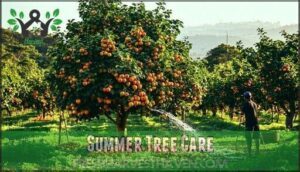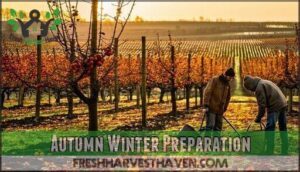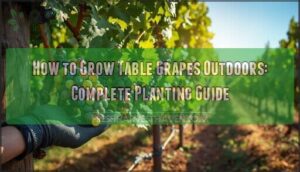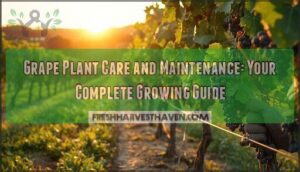This site is supported by our readers. We may earn a commission, at no cost to you, if you purchase through links.
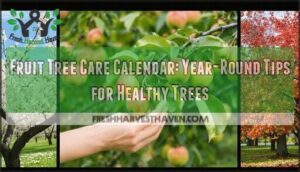 A fruit tree care calendar breaks down essential tasks by season to keep your trees healthy and productive.
A fruit tree care calendar breaks down essential tasks by season to keep your trees healthy and productive.
You’ll plant bare-root trees in late winter, prune for shape in early spring, and fertilize as growth begins.
Summer focuses on pest management, watering, and supporting heavy fruit loads.
Fall means preparing for dormancy with protective measures and final pruning.
Winter’s your chance for major structural pruning while trees rest.
Throughout the year, you’ll monitor for diseases, adjust watering based on weather, and maintain proper mulching to ensure a successful harvest, addressing specific challenges and opportunities that can make or break your harvest success with proper dormancy preparation.
Table Of Contents
- Key Takeaways
- Planting Fruit Trees
- Spring Tree Maintenance
- Summer Tree Care
- Autumn Winter Preparation
- Ongoing Tree Management
- Frequently Asked Questions (FAQs)
- What month should you fertilize fruit trees?
- What maintenance do fruit trees need?
- What month should I prune my fruit trees?
- What not to plant next to fruit trees?
- What month do you fertilize fruit trees?
- What is the watering schedule for fruit trees?
- What is the 123 rule of pruning?
- When do trees start fruiting?
- When should a fruit tree be pruned?
- Should you fertilize fruit trees in the winter?
- Conclusion
Key Takeaways
- You’ll need to match your care tasks to the seasons – plant in late winter, prune in early spring, manage pests in summer, and prepare for dormancy in fall
- Winter dormant pruning is your most critical task – prune between January and March when trees can heal quickly without stress, focusing on removing dead wood and shaping structure
- You can’t skip pest monitoring during the growing season – check weekly for aphids, codling moths, and disease symptoms, using early detection and organic controls to prevent major infestations
- Proper watering makes or breaks your harvest – water deeply but infrequently, with newly planted trees needing water every 2-3 days and mature trees requiring weekly irrigation during dry spells
Planting Fruit Trees
Getting the location and planting timing right sets your fruit trees up for decades of healthy growth and abundant harvests.
You’ll want to choose a sunny spot with well-draining soil and plant when the ground is workable in early spring for the strongest establishment.
Choosing The Right Location and Soil
Without the right location, your fruit tree won’t thrive. Choose carefully to set yourself up for success.
Your fruit tree’s future depends on getting the location right from day one.
- Sunlight Requirements: Select spots with 6-8 hours of direct sunlight daily for maximum fruit production and stronger wood development.
- Soil Drainage: Verify well-draining loamy soil; avoid heavy clay or waterlogged areas that increase root rot risk by 70%.
- Frost Pockets: Skip low-lying areas where cold air settles; choose elevated sites or gentle slopes for better air drainage.
- Soil pH: Conduct a soil test targeting 6.0-7.0 pH range for ideal nutrient uptake and tree health.
- Space Allocation: Plan for mature tree size, removing weeds and guaranteeing adequate room for growth without crowding.
Planting Bare-Root and Balled-and-Burlap Trees
Once you’ve chosen your spot, it’s time to get your hands dirty with the actual planting. Both bare-root and balled-and-burlapped trees offer unique advantages for your fruit tree planting project.
Bare-root advantages include lower cost and easier transport. These trees adapt faster since their roots aren’t confined. Before planting, soak the roots for 2-4 hours to rehydrate them. Check for damaged roots and trim them with clean pruners – this root pruning encourages healthy new growth.
Balled-burlap benefits include less transplant shock and extended planting windows. Keep the root ball moist until planting day. Remove wire cages and cut away the top third of burlap, but leave the rest to decompose naturally.
Planting timing matters most – early spring works best for both types when soil becomes workable. Dig holes twice the root spread’s width but no deeper than the root ball. Post-plant care starts immediately with thorough watering and mulching. Many gardeners find sourcing bare root trees online convenient.
Here’s your planting guide:
Planting Time
Caring for Newly Planted Trees
Once you’ve planted your fruit tree, proper care determines its success.
Initial watering is critical—thoroughly soak the root zone to eliminate air pockets and encourage root development.
Apply 2-3 inches of mulch around the base, keeping it away from the trunk to prevent rot.
Staking methods provide stability in windy areas, but don’t over-tighten.
Sun protection shields young bark from intense rays.
Wait to fertilize until soil settles around roots.
This careful fruit tree care guarantees healthy establishment and vigorous root growth.
Training Young Trees
Training young trees shapes their future productivity and health. Start with central leader training to establish strong upright growth.
Use support systems like stakes and spreaders to create wide branch angles that bear fruit well. Focus on scaffold branch selection early, choosing sturdy branches spaced evenly around the trunk. Remove suckers and water sprouts that compete for energy.
Practice early fruit removal during the first years to strengthen developing branches before heavy fruit loads. Also, remember to select disease-resistant tree varieties to minimize future problems.
- Stakes should allow slight movement to build trunk strength while preventing breakage
- Spreaders positioned at 45-60 degree angles create ideal fruiting wood formation
Spring Tree Maintenance
Spring brings new life to your fruit trees, and it’s the perfect time to set them up for a productive growing season.
You’ll need to tackle essential tasks like pruning, fertilizing, and checking for winter damage to guarantee your trees thrive throughout the year.
Pruning Techniques for Spring
Once you’ve planted your fruit trees, proper pruning techniques will help them thrive for years. Spring pruning timing starts in late winter before bud break, allowing wounds to heal quickly. Sharp, clean tools prevent disease spread—tool sanitization between cuts is non-negotiable.
Selecting the right tools can greatly improve your pruning efficiency; as a result, consider investing in specialized pruning equipment.
Avoid late pruning
Focus branch selection on removing competing leaders and inward-growing limbs. Shaping techniques create open centers for better light penetration. Wound treatment isn’t necessary—clean cuts heal naturally.
Fertilizing for Healthy Growth
Spring marks the perfect time to fuel your fruit trees with proper nutrition.
Start with soil testing to understand your trees’ nutrient needs before applying any fruit tree fertilizer.
Apply organic fertilizer just before bud break for maximum uptake, spreading it evenly around the drip line while avoiding the trunk.
Watch for deficiency symptoms like yellowing leaves throughout the growing season.
Proper fertilization timing guarantees strong growth and abundant fruit production in your fruit tree care calendar.
Assessing Winter Damage
Winter’s harsh grip leaves telltale signs on your fruit trees that you’ll need to address before spring growth begins. Start identifying damage by examining branches for cracks, bark splitting from freeze-thaw cycles, and bud injury from extreme cold.
- Check for rodent damage around the trunk base where hungry critters may have gnawed protective bark
- Look for sunscald on south-facing bark that appears sunken or discolored from winter sun exposure
- Inspect branch crotches and main stems for frost cracks that need immediate attention
Proper tree inspection guarantees your fruit tree winter care efforts pay off during the growing season ahead.
Pruning for Compact Trees
Want compact trees that don’t overwhelm your space? Dwarf tree pruning and espalier pruning techniques make small gardens shine.
Remove central leaders and watersprouts regularly. Container tree pruning requires frequent attention since genetic dwarf varieties grow differently than standard trees.
Rootstock influence affects size, so choose wisely. Conducting a soil test can help guarantee proper tree health.
Summer pruning techniques refine spring’s structural work, creating manageable, productive trees.
Summer Tree Care
Summer brings active growth and fruit development, making it a critical time for maintaining your fruit trees’ health and productivity.
You’ll need to focus on strategic pruning, pest management, branch support, and proper watering to guarantee a successful harvest season.
Pruning for Shape and Structure
During summer’s growing season, fruit tree pruning focuses on tree shaping and structural integrity.
Pruning timing in summer helps control excessive growth while improving airflow improvement and sunlight exposure.
Follow these pruning techniques for effective tree training:
- Remove watersprouts and suckers that drain energy
- Eliminate crossing or rubbing branches for better tree structure
- Thin crowded areas to enhance airflow improvement
- Select strongest scaffold branches for structural integrity
- Maintain your chosen form—Central Leader or Open Center
Summer branch selection strengthens your tree’s foundation for years ahead.
Managing Pests and Diseases
Nobody wants pests turning their summer harvest into a disappointment.
Apply dormant sprays in late winter, then implement IPM strategies throughout the growing season.
Monitor weekly for fruit tree pests like aphids and codling moths—early detection prevents major infestations.
Encourage beneficial insects such as ladybugs to control pest populations naturally.
Practice disease prevention by removing fallen fruit and infected leaves immediately.
Use pest monitoring traps and threshold-based spraying to reduce chemical use while maintaining effective pest control.
Proper disease management keeps your fruit tree diseases under control all season long.
Consider using diatomaceous earth as a safe method to control pests.
Providing Support for Fruiting Branches
When fruit ripens, heavy loads can snap branches without warning. You’ll need branch support methods and propping techniques to prevent costly damage.
Here’s your fruit load management strategy:
- Install trellis systems or stakes before fruit swells
- Use soft ties to secure heavy branches gently
- Prop branches with Y-shaped supports under weight
- Combine with fruit thinning for balanced loads
Your fruit tree care calendar should include early support setup. Tree propping branches prevents breakage while maintaining healthy growth patterns.
Watering and Mulching
Your fruit trees need consistent hydration during summer’s heat. Deep watering once weekly encourages strong root development and prevents stress-related issues.
Mulching acts like a protective blanket, conserving soil moisture while suppressing weeds. Apply organic mulch types around your trees, maintaining proper depth for ideal root hydration.
- Watering frequency: Deep weekly sessions trump daily shallow sprinkles
- Mulch types: Wood chips, straw, or shredded leaves work best
- Winter mulching: Expand mulch rings before cold weather arrives
Autumn Winter Preparation
As autumn arrives, you’ll shift your focus from growing to preparing your fruit trees for winter’s challenges.
This season combines strategic pruning decisions with essential protection measures that guarantee your trees emerge healthy and ready for next year’s growing season, which involves strategic planning.
Autumn Pruning Considerations
Fall marks the perfect time for mature shaping and removing rootstock suckers from your fruit trees.
Focus on dormant pruning techniques that prepare trees for winter’s harsh conditions. Always practice tool sanitization between cuts to prevent disease spread.
Apply wound protection to larger cuts immediately after pruning.
| Pruning Task | Timing | Purpose |
|---|---|---|
| Remove suckers | Early fall | Redirect energy to main tree |
| Shape mature trees | Late fall | Improve structure and airflow |
| Cut diseased wood | Throughout season | Prevent pathogen spread |
| Apply wound sealant | After major cuts | Protect against winter damage |
Winter Pruning for Health and Growth
Winter sets the stage for your most important pruning work. Dormancy Pruning during late winter maximizes tree health while minimizing stress. This Tree Pruning Timing guarantees wounds heal properly before spring growth begins.
Dormant Pruning requires sharp, sanitized tools for clean cuts. Focus on Structural Integrity by removing problematic branches that compete for resources or block sunlight.
Essential winter pruning tasks include:
- Remove dead, diseased, or damaged wood completely
- Thin overcrowded branches for Airflow Enhancement
- Cut vertical waterspouts that drain tree energy
- Tool Sanitization between cuts prevents disease spread
- Apply Wound Sealing compound on larger cuts
These Tree Pruning Techniques prepare your trees for vigorous spring growth while maintaining their natural shape.
Protecting Trees From Harsh Weather
Smart protection strategies shield your trees from winter’s harsh conditions. Use tree wraps for sunscald prevention and frost protection measures like mulching roots before freezing weather hits.
Prune weak branches to prevent wind damage and snow load breakage. Also, remember to clear fallen leaves to prevent overwintering pest issues.
Combine tree insulation techniques with strategic winter watering for thorough fruit tree protection.
Preparing for Dormancy
As your trees settle into their dormant season, you’ll need to focus on essential winter protection tasks.
Apply mulch around the base for root insulation and rodent protection through tree wrapping of younger trunks.
Add soil amendments like compost to improve spring growth.
Continue winter watering during dry spells above freezing.
Remove fallen leaves to prevent disease carryover.
Your fruit tree care calendar should include these fruit tree fall care steps for ideal tree dormancy preparation and successful fruit tree winter protection.
Ongoing Tree Management
Successful fruit tree care requires consistent attention throughout the year to maintain healthy, productive trees.
You’ll need to monitor four key areas regularly: pest and disease management, proper watering techniques, strategic fertilizing, and targeted pruning for maximum fruit production.
Monitoring for Pests and Diseases
After protecting your trees through winter, vigilant monitoring becomes your next defense against threats.
Success in pest identification and disease prevention depends on regular inspection and early detection.
Watch for these warning signs:
- Curled or discolored leaves indicating aphid infestations
- Sticky honeydew residue from scale insects
- Brown spots or unusual leaf patterns suggesting fungal diseases
- Holes in fruit from codling moth larvae
- Wilted branches showing fire blight symptoms
Implement IPM strategies and organic controls immediately when problems appear.
Consider using natural pest solutions for effective control.
Watering and Irrigation Techniques
Through proper irrigation management, you’ll establish a fruit tree watering schedule that promotes deep root growth.
Check soil moisture regularly using your finger or moisture meter to prevent drought stress.
Drip irrigation delivers water precisely to root zones, improving water conservation by fifty percent compared to sprinklers.
Watering frequency depends on tree age and season—newly planted trees need water every two to three days, while mature trees require irrigation weekly.
Mulching reduces evaporation, maintaining consistent moisture levels essential for healthy fruit tree watering.
Fertilizing for Optimal Growth
Consistent fertilization keeps your fruit trees thriving throughout the growing season.
Soil testing reveals your trees’ specific nutrient needs before you begin feeding.
- Apply organic fertilizer in early spring before bud break for maximum uptake
- Watch for deficiency symptoms like yellowing leaves or poor fruit development
- Time applications carefully—avoid late-season feeding that encourages tender growth
Following a proper fruit tree fertilization schedule with attention to nutrient timing guarantees healthy, productive harvests year after year.
Pruning for Fruit Production
Smart fruit tree pruning guide timing matters more than you might think. Your fruit tree care calendar should include winter dormant pruning for maximum impact.
Dormant pruning removes dead, diseased branches while trees rest. Fruit spur health depends on proper pruning tools and shaping techniques. Pruning intensity varies by tree type, but fruit tree pruning techniques focus on opening canopies for sunlight penetration.
Tree pruning techniques that work:
- Remove crossing or rubbing branches first
- Cut back one-third of previous year’s growth
- Thin fruiting spurs every few years
- Make clean cuts just above outward-facing buds
Frequently Asked Questions (FAQs)
What month should you fertilize fruit trees?
March makes marvelous timing for fertilizing fruit trees.
You’ll want to apply fertilizer just before bloom begins, maximizing nutrient uptake while minimizing leaching.
Apply 5-10-10 fertilizer around newly planted trees in April, keeping it away from the base.
What maintenance do fruit trees need?
You’ll need to prune, fertilize, water, and monitor for pests throughout the year.
Winter pruning shapes trees, spring fertilizing feeds growth, summer watering sustains health, and regular pest control protects your harvest.
Regular monitoring for pests is crucial to protect your harvest.
What month should I prune my fruit trees?
When’s the best time to wield those pruning shears?
Prune apples and pears in February, cherries and plums also in February.
Then tackle peaches, nectarines, and apricots in late winter through March for best results.
What not to plant next to fruit trees?
Avoid planting walnut trees, which release growth-inhibiting chemicals.
Don’t plant large shade trees that’ll compete for sunlight and nutrients.
Skip aggressive spreaders like mint or bamboo that’ll overwhelm your fruit trees’ root systems.
What month do you fertilize fruit trees?
Trees gobble up to 2 pounds of nutrients yearly.
You’ll fertilize fruit trees in March, just before bloom time.
Apply slow-release organic fertilizer between January and March for best results.
Time it right, and you’ll reap nature’s sweetest rewards.
What is the watering schedule for fruit trees?
You’ll want to water newly planted trees thoroughly and consistently during their first year.
For established trees, water deeply but infrequently, checking soil moisture regularly.
Water in January if it’s dry and warm, expanding mulch rings in December when temperatures stay above freezing.
What is the 123 rule of pruning?
Like a lighthouse guiding ships through fog, the 1-2-3 rule keeps your fruit trees on course for peak production.
You’ll maintain one-third one-year-old laterals, one-third two-year-old fruiting wood, and one-third three-year-old wood that’s cut back hard to generate new growth, ensuring productive renewal cycles.
When do trees start fruiting?
Most fruit trees start producing fruit 2-6 years after planting, depending on the variety and rootstock.
Dwarf trees fruit sooner than standard-sized trees, while some stone fruits begin earlier than apples.
When should a fruit tree be pruned?
Pruning timing isn’t just about calendar dates—it’s about tree biology.
You’ll get best results pruning during late winter dormancy, typically January through March, when trees can heal quickly without stress.
Should you fertilize fruit trees in the winter?
Yes, you should fertilize fruit trees in winter.
Apply slow-release organic fertilizer between January and March when trees are dormant.
This timing allows nutrients to become available as growth begins in spring.
Conclusion
Following the ancient proverb that "the best time to plant a tree was 20 years ago, the second best time is now," your fruit tree care calendar becomes your roadmap to success.
You’ll master seasonal tasks from winter’s dormant pruning to summer’s pest battles. Consistent care throughout each season guarantees healthy trees that reward you with abundant harvests.
Your dedication to this fruit tree care calendar transforms simple saplings into productive orchards.





